
Maulbronn Monastery is a former Cistercian abbey and ecclesiastical state in the Holy Roman Empire located at Maulbronn, Baden-Württemberg. The monastery complex, one of the best-preserved in Europe, was named a UNESCO World Heritage Site in 1993.

Zwettl Abbey is a Cistercian monastery located in Zwettl in Lower Austria, in the Diocese of St. Pölten.

Pforta, or Schulpforta, is a school located in Pforta monastery, a former Cistercian monastery (1137–1540), near Naumburg on the Saale River in the German state of Saxony-Anhalt.
Ilfeld is a village and a former municipality in the district of Nordhausen, in Thuringia, Germany. It is situated at the south foot of the Harz, at the entrance to the Bährethal, 8 miles (13 km) north from Nordhausen by the railway to Wernigerode. Since 1 January 2012, it has been part of the municipality of Harztor.

Ilsenburg Abbey was a monastery of the Benedictine Order located at Ilsenburg near Wernigerode, in Saxony-Anhalt in Germany. The former abbey is a stop on the Romanesque Road.
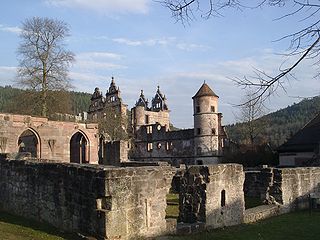
Hirsau Abbey, formerly known as Hirschau Abbey, was once one of the most important Benedictine abbeys of Germany. It is located in the Hirsau borough of Calw on the northern slopes of the Black Forest mountain range, in the present-day state of Baden-Württemberg. In the 11th and 12th century, the monastery was a centre of the Cluniac Reforms, implemented as "Hirsau Reforms" in the German lands by William of Hirsau. The complex was devastated during the War of the Palatine Succession in 1692 and not rebuilt.
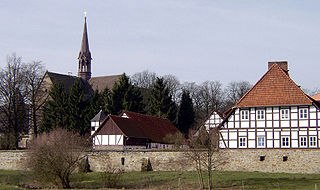
Loccum Abbey is a Lutheran monastery in the town of Rehburg-Loccum, Lower Saxony, near Steinhude Lake.

Salem Abbey was a very prominent Cistercian monastery in Salem in the district of Bodensee about ten miles from Konstanz, Baden-Württemberg, Germany. The buildings are now owned by the State of Baden-Württemberg and are open for tours as the Salem Monastery and Palace.

Sittichenbach Abbey, sometimes also known as Sichem Abbey, is a Cistercian monastery in Sittichenbach, now part of Osterhausen near Eisleben in the Mansfeld-Südharz district, Saxony-Anhalt, Germany.

Herrenalb Abbey is a former Cistercian monastery in the present Bad Herrenalb in Baden-Württemberg, Germany.

Riddagshausen Abbey was a Cistercian monastery just outside the city of Brunswick in Germany.

Bebenhausen Abbey is a former Cistercian monastery complex located in Bebenhausen, Baden-Württemberg, Germany. The complex is also the location of Bebenhausen Palace, a hunting retreat created and maintained by two Kings of Württemberg. The complex was named a historic monument in 1974.
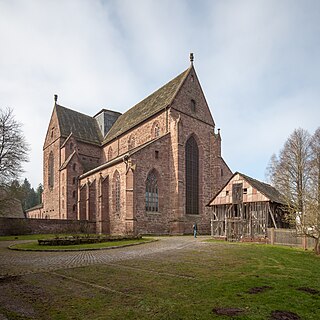
Amelungsborn Abbey, also Amelunxborn Abbey, is a Lutheran monastery in Germany. It is located near Negenborn and Stadtoldendorf, in the Landkreis of Holzminden in the Weserbergland. It was the second oldest Cistercian foundation in Lower Saxony, Germany, after Walkenried Abbey. It survived the Reformation by becoming Lutheran, and with Loccum Abbey, also previously Cistercian, is one of the only two Lutheran monasteries in Germany with an uninterrupted tradition. The abbey church, St. Mary's, is also the parish church of the abbey's former estate villages Negenborn and Holenberg.
Michaelstein Abbey is a former Cistercian monastery, now the home of the Stiftung Kloster Michaelstein - Musikinstitut für Aufführungspraxis, near the town of Blankenburg in the Harz in Sachsen-Anhalt, Germany.
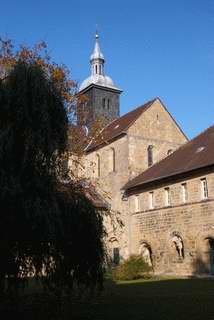
Mariental Abbey, in the present-day municipality of Mariental in Lower Saxony, Germany, is a former Cistercian monastery founded in 1138, now used and owned by a Lutheran congregation of the Evangelical Lutheran Church in Brunswick.
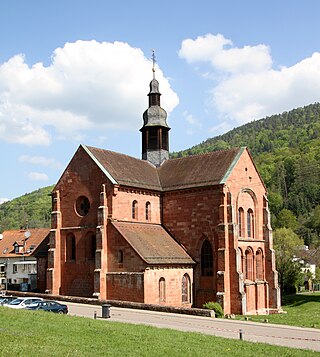
Eusserthal Abbey was a Cistercian abbey in Eusserthal near Annweiler am Trifels in the Rhineland-Palatinate, Germany. All that now remains of it is the front portion of the abbey church, which is now used as a parish church.
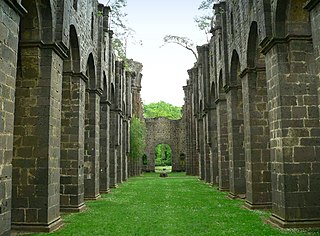
Arnsburg Abbey is a former Cistercian monastery near Lich in the Wetterau, Hesse, Germany. It was founded by monks from Eberbach Abbey in 1174. Although heavily damaged in the Thirty Years' War it was rebuilt later in the 17th century and prospered in the 18th century, when much of the abbey was rebuilt in Baroque style.
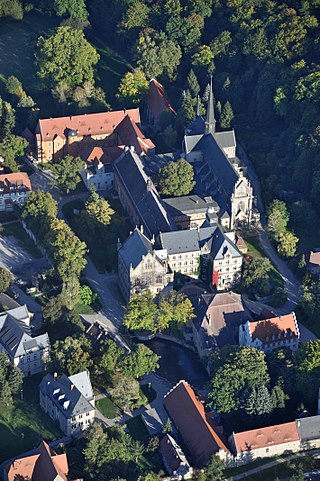
The Pforta monastery is a former Cistercian monastery located near Naumburg in Saxony-Anhalt, Germany. It was established in the 1130s and prospered in the Middle Ages. In the course of the Reformation the monastery was disbanded in 1540. Today the buildings are used by the school Landesschule Pforta. The site is located on the tourist route Romanesque Road and has been nominated by Germany for inclusion in the UNESCO list of World Heritage Sites.
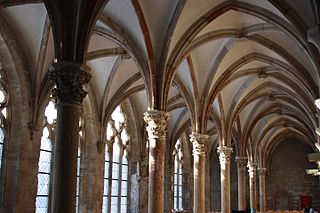
The Walkenrieder Kreuzgangkonzerte have been the annual music festival of Walkenried Abbey in Lower Saxony Göttingen district since 1983.






















